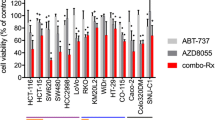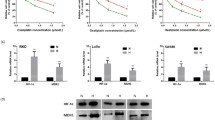Abstract
Background and Aims
In vitro studies have shown that clusterin modulates treatment sensitivity in a number of human cancers; however, the interaction between clusterin expression and hypoxia in controlling treatment response in CRC has not previously been examined. The aim of this study was to assess the effect of clusterin overexpression in CRC cells on sensitivity to 5-fluorouracil (5-FU), oxaliplatin and FOLFOX treatment under normoxic and graded hypoxic conditions.
Methods
SW480 colon cancer cells were transfected with full length Clusterin cDNA to generate a clusterin overexpressing cell line. Overexpression was confirmed by western blot analysis. The response of parental and clusterin overexpressing cells to 5-FU, oxaliplatin and FOLFOX was examined using a crystal violet-based proliferation assay under normoxic conditions, 3% and 1% hypoxic conditions. The levels of apoptosis and G2/M arrest in FOLFOX-treated cells were assessed by flow cytometry.
Results
Under normoxic conditions, clusterin overexpressing cells were more sensitive to FOLFOX treatment (p = 0.01); under 3% and 1% hypoxic conditions, overexpressing clusterin cells were more sensitive to 5-FU, oxaliplatin and FOLFOX, p values <0.05 for all conditions. Under normoxic conditions, overexpressing clusterin cells showed significantly higher levels of apoptosis when treated with FOLFOX compared to untransfected cells; levels of G2M cells were not significantly different. Under both 3% and 1% hypoxia, the percentage of cells undergoing apoptosis following FOLFOX treatment was significantly higher in overexpressing clusterin cells.
Conclusion
These in vitro findings suggest that tumours expressing high levels of clusterin, particularly if hypoxic in nature, may benefit from treatments such as FOLFOX.



Similar content being viewed by others
References
Trougakos IP, Gonos ES. Clusterin/apolipoprotein J in human aging and cancer. Int J Biochem Cell Biol. 2002;34(11):1430–48.
Pucci S, Bonanno E, Pichiorri F, Angeloni C, Spagnoli LG. Modulation of different clusterin isoforms in human colon tumorigenesis. Oncogene. 2004;23(13):2298–304. doi:10.1038/sj.onc.1207404.
Shannan B, Seifert M, Leskov K, Willis J, Boothman D, Tilgen W, et al. Challenge and promise: roles for clusterin in pathogenesis, progression and therapy of cancer. Cell Death Differ. 2006;13(1):12–9. doi:10.1038/sj.cdd.4401779.
Andersen CL, Schepeler T, Thorsen K, Birkenkamp-Demtroder K, Mansilla F, Aaltonen LA, et al. Clusterin expression in normal mucosa and colorectal cancer. Mol Cell Proteomics. 2007;6(6):1039–48. doi:10.1074/mcp.M600261-MCP200.
Lakins J, Bennett SA, Chen JH, Arnold JM, Morrissey C, Wong P, et al. Clusterin biogenesis is altered during apoptosis in the regressing rat ventral prostate. J Biol Chem. 1998;273(43):27887–95.
O’Sullivan J, Whyte L, Drake J, Tenniswood M. Alterations in the post-translational modification and intracellular trafficking of clusterin in MCF-7 cells during apoptosis. Cell Death Differ. 2003;10(8):914–27. doi:10.1038/sj.cdd.4401254.
Wilson MR, Easterbrook-Smith SB. Clusterin binds by a multivalent mechanism to the Fc and Fab regions of IgG. Biochim Biophys Acta. 1992;1159(3):319–26.
de Silva HV, Harmony JA, Stuart WD, Gil CM, Robbins J. Apolipoprotein J: structure and tissue distribution. Biochemistry. 1990;29(22):5380–9.
Jenne DE, Lowin B, Peitsch MC, Bottcher A, Schmitz G, Tschopp J. Clusterin (complement lysis inhibitor) forms a high density lipoprotein complex with apolipoprotein A-I in human plasma. J Biol Chem. 1991;266(17):11030–6.
Li DQ, Ljungh A. Binding of human clusterin by Staphylococcus epidermidis. FEMS Immunol Med Microbiol. 2001;31(3):197–202.
Matsubara E, Soto C, Governale S, Frangione B, Ghiso J. Apolipoprotein J and Alzheimer’s amyloid beta solubility. Biochem J. 1996;316(Pt 2):671–9.
Kujiraoka T, Hattori H, Miwa Y, Ishihara M, Ueno T, Ishii J, et al. Serum apolipoprotein j in health, coronary heart disease and type 2 diabetes mellitus. J Atheroscler Thromb. 2006;13(6):314–22.
Bajari TM, Strasser V, Nimpf J, Schneider WJ. A model for modulation of leptin activity by association with clusterin. FASEB J. 2003;17(11):1505–7. doi:10.1096/fj.02-1106fje.
Matsuda A, Itoh Y, Koshikawa N, Akizawa T, Yana I, Seiki M. Clusterin, an abundant serum factor, is a possible negative regulator of MT6-MMP/MMP-25 produced by neutrophils. J Biol Chem. 2003;278(38):36350–7. doi:10.1074/jbc.M301509200.
Leskov KS, Klokov DY, Li J, Kinsella TJ, Boothman DA. Synthesis and functional analyses of nuclear clusterin, a cell death protein. J Biol Chem. 2003;278(13):11590–600. doi:10.1074/jbc.M209233200.
Miyake H, Nelson C, Rennie PS, Gleave ME. Acquisition of chemoresistant phenotype by overexpression of the antiapoptotic gene testosterone-repressed prostate message-2 in prostate cancer xenograft models. Cancer Res. 2000;60(9):2547–54.
Cervellera M, Raschella G, Santilli G, Tanno B, Ventura A, Mancini C, et al. Direct transactivation of the anti-apoptotic gene apolipoprotein J (clusterin) by B-MYB. J Biol Chem. 2000;275(28):21055–60. doi:10.1074/jbc.M002055200.
Zellweger T, Chi K, Miyake H, Adomat H, Kiyama S, Skov K, et al. Enhanced radiation sensitivity in prostate cancer by inhibition of the cell survival protein clusterin. Clin Cancer Res. 2002;8(10):3276–84.
Muramaki M, So A, Hayashi N, Sowery R, Miyake H, Fujisawa M, et al. Chemosensitization of gemcitabine-resistant human bladder cancer cell line both in vitro and in vivo using antisense oligonucleotide targeting the anti-apoptotic gene, clusterin. BJU Int. 2009;103(3):384–90. doi:10.1111/j.1464-410X.2008.08098.x.
Yamanaka K, Gleave M, Muramaki M, Hara I, Miyake H. Enhanced radiosensitivity by inhibition of the anti-apoptotic gene clusterin using antisense oligodeoxynucleotide in a human bladder cancer model. Oncol Rep. 2005;13(5):885–90.
Toffanin S, Daidone MG, Miodini P, De Cecco L, Gandellini P, Cappelletti V. Clusterin: a potential target for improving response to antiestrogens. Int J Oncol. 2008;33(4):791–8.
Gleave M, Miyake H. Use of antisense oligonucleotides targeting the cytoprotective gene, clusterin, to enhance androgen- and chemo-sensitivity in prostate cancer. World J Urol. 2005;23(1):38–46. doi:10.1007/s00345-004-0474-0.
Vaupel P, Thews O, Hoeckel M. Treatment resistance of solid tumors: role of hypoxia and anemia. Med Oncol. 2001;18(4):243–59. doi:10.1385/MO:18:4:243.
Vaupel P, Mayer A, Hockel M. Tumor hypoxia and malignant progression. Methods Enzymol. 2004;381:335–54. doi:10.1016/S0076-6879(04)81023-1.
Trougakos IP, So A, Jansen B, Gleave ME, Gonos ES. Silencing expression of the clusterin/apolipoprotein j gene in human cancer cells using small interfering RNA induces spontaneous apoptosis, reduced growth ability, and cell sensitization to genotoxic and oxidative stress. Cancer Res. 2004;64(5):1834–42.
Bettuzzi S, Scorcioni F, Astancolle S, Davalli P, Scaltriti M, Corti A. Clusterin (SGP-2) transient overexpression decreases proliferation rate of SV40-immortalized human prostate epithelial cells by slowing down cell cycle progression. Oncogene. 2002;21(27):4328–34. doi:10.1038/sj.onc.1205594.
Yang CR, Leskov K, Hosley-Eberlein K, Criswell T, Pink JJ, Kinsella TJ, et al. Nuclear clusterin/XIP8, an X-ray-induced Ku70-binding protein that signals cell death. Proc Natl Acad Sci USA. 2000;97(11):5907–12.
Yotnda P, Wu D, Swanson AM. Hypoxic tumors and their effect on immune cells and cancer therapy. Methods Mol Biol. 2010;651:1–29. doi:10.1007/978-1-60761-786-0_1.
Giatromanolaki A, Harris AL. Tumour hypoxia, hypoxia signaling pathways and hypoxia inducible factor expression in human cancer. Anticancer Res. 2001;21(6B):4317–24.
Voss MJ, Niggemann B, Zanker KS, Entschladen F. Tumour reactions to hypoxia. Curr Mol Med. 2010;10(4):381–6.
Brahimi-Horn MC, Chiche J, Pouyssegur J. Hypoxia and cancer. J Mol Med. 2007;85(12):1301–7. doi:10.1007/s00109-007-0281-3.
Vaupel P. The role of hypoxia-induced factors in tumor progression. Oncologist. 2004;9 Suppl 5:10–7. doi:10.1634/theoncologist.9-90005-10.
Liao D, Johnson RS. Hypoxia: a key regulator of angiogenesis in cancer. Cancer Metastasis Rev. 2007;26(2):281–90. doi:10.1007/s10555-007-9066-y.
Kim JW, Gao P, Dang CV. Effects of hypoxia on tumor metabolism. Cancer Metastasis Rev. 2007;26(2):291–8. doi:10.1007/s10555-007-9060-4.
Cerniglia GJ, Pore N, Tsai JH, Schultz S, Mick R, Choe R, et al. Epidermal growth factor receptor inhibition modulates the microenvironment by vascular normalization to improve chemotherapy and radiotherapy efficacy. PLoS ONE. 2009;4(8):e6539. doi:10.1371/journal.pone.0006539.
Tamm M, Bihl M, Eickelberg O, Stulz P, Perruchoud AP, Roth M. Hypoxia-induced interleukin-6 and interleukin-8 production is mediated by platelet-activating factor and platelet-derived growth factor in primary human lung cells. Am J Respir Cell Mol Biol. 1998;19(4):653–61.
Baggiolini M, Clark-Lewis I. Interleukin-8, a chemotactic and inflammatory cytokine. FEBS Lett. 1992;307(1):97–101.
Ning Y, Manegold PC, Hong YK, Zhang W, Pohl A, Lurje G, et al. Interleukin-8 is associated with proliferation, migration, angiogenesis and chemosensitivity in vitro and in vivo in colon cancer cell line models. Int J Cancer. 2011;128(9):2038–49. doi:10.1002/ijc.25562.
Wang Y, Guo XQ, Niu XL, Wu J, Zhu YQ, Mao LQ. Relationship of IL-6 and IL-8 secretion in epithelial ovarian cancer cell lines with their sensitivity to tamoxifen as well as MAPK, Akt and estrogen receptor phosphorylation. Xi Bao Yu Fen Zi Mian Yi Xue Za Zhi. 2010;26(1):21–4.
Wilson C, Wilson T, Johnston PG, Longley DB, Waugh DJ. Interleukin-8 signaling attenuates TRAIL- and chemotherapy-induced apoptosis through transcriptional regulation of c-FLIP in prostate cancer cells. Mol Cancer Ther. 2008;7(9):2649–61. doi:10.1158/1535-7163.MCT-08-0148.
Miyake H, Yamanaka K, Muramaki M, Kurahashi T, Gleave M, Hara I. Enhanced expression of the secreted form of clusterin following neoadjuvant hormonal therapy as a prognostic predictor in patients undergoing radical prostatectomy for prostate cancer. Oncol Rep. 2005;14(5):1371–5.
Kurahashi T, Muramaki M, Yamanaka K, Hara I, Miyake H. Expression of the secreted form of clusterin protein in renal cell carcinoma as a predictor of disease extension. BJU Int. 2005;96(6):895–9. doi:10.1111/j.1464-410X.2005.05733.x.
Xie D, Lau SH, Sham JS, Wu QL, Fang Y, Liang LZ, et al. Up-regulated expression of cytoplasmic clusterin in human ovarian carcinoma. Cancer. 2005;103(2):277–83. doi:10.1002/cncr.20765.
Watari H, Ohta Y, Hassan MK, Xiong Y, Tanaka S, Sakuragi N. Clusterin expression predicts survival of invasive cervical cancer patients treated with radical hysterectomy and systematic lymphadenectomy. Gynecol Oncol. 2008;108(3):527–32. doi:10.1016/j.ygyno.2007.11.026.
Kang YK, Hong SW, Lee H, Kim WH. Overexpression of clusterin in human hepatocellular carcinoma. Hum Pathol. 2004;35(11):1340–6. doi:10.1016/j.humpath.2004.07.021.
Xie MJ, Motoo Y, Su SB, Mouri H, Ohtsubo K, Matsubara F, et al. Expression of clusterin in human pancreatic cancer. Pancreas. 2002;25(3):234–8.
Albert JM, Gonzalez A, Massion PP, Chen H, Olson SJ, Shyr Y, et al. Cytoplasmic clusterin expression is associated with longer survival in patients with resected non small cell lung cancer. Cancer Epidemiol Biomarkers Prev. 2007;16(9):1845–51. doi:10.1158/1055-9965.EPI-07-0146.
Kevans D, Foley J, Tenniswood M, Sheahan K, Hyland J, O’Donoghue D, et al. High clusterin expression correlates with a poor outcome in stage II colorectal cancers. Cancer Epidemiol Biomarkers Prev. 2009;18(2):393–9. doi:10.1158/1055-9965.EPI-08-0302.
Disclosures
The authors declare that they have no conflict of interest or financial support to disclose in relation to this article.
Author information
Authors and Affiliations
Corresponding author
Rights and permissions
About this article
Cite this article
Kevans, D., Gorman, S., Tosetto, M. et al. Clusterin and Chemotherapy Sensitivity Under Normoxic and Graded Hypoxic Conditions in Colorectal Cancer. J Gastrointest Canc 43, 305–313 (2012). https://doi.org/10.1007/s12029-011-9277-x
Published:
Issue Date:
DOI: https://doi.org/10.1007/s12029-011-9277-x




